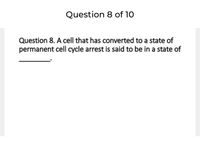
Human Anatomy & Physiology (11th Edition)
11th Edition
ISBN: 9780134580999
Author: Elaine N. Marieb, Katja N. Hoehn
Publisher: PEARSON
expand_more
expand_more
format_list_bulleted
Concept explainers
Question

Transcribed Image Text:Question 8 of 10
Question 8. A cell that has converted to a state of
permanent cell cycle arrest is said to be in a state of
Expert Solution
This question has been solved!
Explore an expertly crafted, step-by-step solution for a thorough understanding of key concepts.
This is a popular solution
Trending nowThis is a popular solution!
Step by stepSolved in 2 steps

Knowledge Booster
Learn more about
Need a deep-dive on the concept behind this application? Look no further. Learn more about this topic, biology and related others by exploring similar questions and additional content below.Similar questions
- QUESTION 49 Which of the following is not true/accurate with respect to p53? a. is a tumor-suppressor b. is a transcription factor that promotes transcription of inhibitors of the cell cycle c. is an oncogene d. is named for its molecular mass (in kiloDaltons)arrow_forwardQuestion 2 All of the following are consequences of short wavelength UV irradiation EXCEPT (which is false?- best answer) O inhibition of transcription increase in mutations O decrease protein synthesis inhibition of DNA repliaction cell membrane rupture/lysisarrow_forwardTrue or false: A somatic cell mutation may be passed on to offspring. arrow_forward
- Question 50 50. Which of the following represents the inactive 7-chromatin in female cells? O euchromatin O heterochromatin O genomic equivalence O genomic imprinting O dosage compensation Previousarrow_forwardQUESTION 13 The phenomenon by which an allele containing a deletion in a tumor suppressor gene causes a good copy of the gene carried on the other allele to undergo deletion is an example of A. Penetrance OB. Chromatid dysjunction O C. Loss of heterozygosity O D. Allelic exclusion O E. Chromosomal translocationarrow_forwardQUESTION 31 You are a new PhD student in the lab of Dr. Adenine and start noticing that many of the cells you are studying for your project have two centrosomes. You realize that a defect during one specific phase of the cell cycle could explain this double-centrosome phenotype. A defect during which phase is most likely to be the culprit? G1 phase. Metaphase. G2 phase. O Interphase.arrow_forward
- QUESTION 5 The experiment below illustrates the results of deletion of a gene involved in forming this critical complex. Complex Chromosomes from a normal cell Normal After deletion of Protein X fusedarrow_forwardQUESTION 17 Which of the following events describe the mechanism of a cell cycle checkpoint? (choose more than one if applicable) If you really want to challenge yourself, figure out which cell cycle checkpoint is described by each of your choices. Questions about this topic are commonly missed on the unit 3 exam! U A Cdk is phosphorylated, turning it off. This prevents the cell from entering the next phase before it is ready. A ubiquitin ligase is activated to target a Cdk for destruction. Since the Cdk is destroyed, it cannot be active and therefore cannot cause entry into the next phase of the cell cycle. A Cdk inhibitor protein is transcribed and translated when it otherwise wouldn't be, which turns off a Cdk and prevents the cell from entering the next phase before it's ready. A ubiquitin ligase is inhibited, preventing the proteolysis of proteins that must be destroyed in order for the cell to advance to the next step in the cell cycle. One of these proteins that is not destroyed…arrow_forward1. How did your results differ from the class data for each phase of mitosis? 2. Write a brief paragraph stating whether or not your hypothesis was supported by the class data that you collected and an explanation of why/why not.arrow_forward
arrow_back_ios
SEE MORE QUESTIONS
arrow_forward_ios
Recommended textbooks for you
 Human Anatomy & Physiology (11th Edition)BiologyISBN:9780134580999Author:Elaine N. Marieb, Katja N. HoehnPublisher:PEARSON
Human Anatomy & Physiology (11th Edition)BiologyISBN:9780134580999Author:Elaine N. Marieb, Katja N. HoehnPublisher:PEARSON Biology 2eBiologyISBN:9781947172517Author:Matthew Douglas, Jung Choi, Mary Ann ClarkPublisher:OpenStax
Biology 2eBiologyISBN:9781947172517Author:Matthew Douglas, Jung Choi, Mary Ann ClarkPublisher:OpenStax Anatomy & PhysiologyBiologyISBN:9781259398629Author:McKinley, Michael P., O'loughlin, Valerie Dean, Bidle, Theresa StouterPublisher:Mcgraw Hill Education,
Anatomy & PhysiologyBiologyISBN:9781259398629Author:McKinley, Michael P., O'loughlin, Valerie Dean, Bidle, Theresa StouterPublisher:Mcgraw Hill Education, Molecular Biology of the Cell (Sixth Edition)BiologyISBN:9780815344322Author:Bruce Alberts, Alexander D. Johnson, Julian Lewis, David Morgan, Martin Raff, Keith Roberts, Peter WalterPublisher:W. W. Norton & Company
Molecular Biology of the Cell (Sixth Edition)BiologyISBN:9780815344322Author:Bruce Alberts, Alexander D. Johnson, Julian Lewis, David Morgan, Martin Raff, Keith Roberts, Peter WalterPublisher:W. W. Norton & Company Laboratory Manual For Human Anatomy & PhysiologyBiologyISBN:9781260159363Author:Martin, Terry R., Prentice-craver, CynthiaPublisher:McGraw-Hill Publishing Co.
Laboratory Manual For Human Anatomy & PhysiologyBiologyISBN:9781260159363Author:Martin, Terry R., Prentice-craver, CynthiaPublisher:McGraw-Hill Publishing Co. Inquiry Into Life (16th Edition)BiologyISBN:9781260231700Author:Sylvia S. Mader, Michael WindelspechtPublisher:McGraw Hill Education
Inquiry Into Life (16th Edition)BiologyISBN:9781260231700Author:Sylvia S. Mader, Michael WindelspechtPublisher:McGraw Hill Education

Human Anatomy & Physiology (11th Edition)
Biology
ISBN:9780134580999
Author:Elaine N. Marieb, Katja N. Hoehn
Publisher:PEARSON

Biology 2e
Biology
ISBN:9781947172517
Author:Matthew Douglas, Jung Choi, Mary Ann Clark
Publisher:OpenStax

Anatomy & Physiology
Biology
ISBN:9781259398629
Author:McKinley, Michael P., O'loughlin, Valerie Dean, Bidle, Theresa Stouter
Publisher:Mcgraw Hill Education,

Molecular Biology of the Cell (Sixth Edition)
Biology
ISBN:9780815344322
Author:Bruce Alberts, Alexander D. Johnson, Julian Lewis, David Morgan, Martin Raff, Keith Roberts, Peter Walter
Publisher:W. W. Norton & Company

Laboratory Manual For Human Anatomy & Physiology
Biology
ISBN:9781260159363
Author:Martin, Terry R., Prentice-craver, Cynthia
Publisher:McGraw-Hill Publishing Co.

Inquiry Into Life (16th Edition)
Biology
ISBN:9781260231700
Author:Sylvia S. Mader, Michael Windelspecht
Publisher:McGraw Hill Education